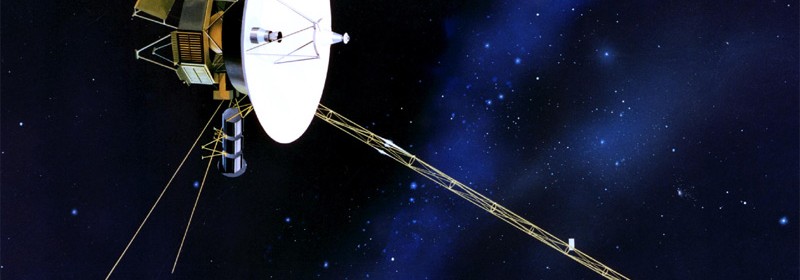In September 2013, NASA announced that the Voyager 1 probe had successfully entered interstellar space; the first human-made object to do so. As the probe continues forth into the vast unknown, it carries with it a special collection of “welcome signs” for any life forms it may encounter. Known as the Voyager Golden Record, this 12” gold plated copper disc was designed to operate similarly to a phonograph record. The disc is filled with sounds and images from Earth. Carefully selected by a committee led by Dr. Carl Sagan of Cornell University, the Voyager Golden Record includes the following:
- Sounds from nature, including thunder and wind, and animals such as whales and birds
- 55 spoken greetings in various Earth dialects, both ancient and modern
- Printed messages from US President Jimmy Carter and UN Secretary General Kurt Waldheim
- A 90-minute collection of music from various cultures
- 115 images from Earth
Both the Voyager 1 and Voyager 2 probes carry a copy of the Voyager Golden Record. The record was designed to be played at a speed of 16 2/3 rotations per minute; half the speed of traditional vinyl records. Not to leave the greeting without an instruction manual, NASA meticulously crafted a cover for the record, using a collection of images and binary code to provide the proper setup needed to play the record that would transcend any language barrier. A stylus is included with the record to allow for it to be played.
The upper left portion of the record’s cover shows visual directions for how to properly play the record, including placement of the stylus to the record, playing from the outside of the record to the inside, and the speed at which to play the record. The lower left portion features a pulsar map, previously included on plaques for Voyager’s predecessors, the Pioneer 10 and 11 probes. The map shows the position of the sun in relation to 14 different pulsars. The upper right portion shows how to extrapolate the images from the disc, using the signal, which decodes to a series of 512 vertical lines. It also includes an image of a circle, the first image used to verify that the images have been decoded correctly. The time scale with which to use as reference is the final piece of the puzzle, showcased in the image on the bottom right. Instead of relying on seconds and minutes (derived from Earth’s rotation), the code on the Golden Record relies on the fundamental transition of the hydrogen atom (approximately 0,70 billionths of a second) as the preferred time scale.
While the likelihood of encountering intelligent life along Voyager 1’s current trajectory may be minimal (even equated by Dr. Sagan as tossing a “bottle into the cosmic ocean”), the Golden Record serves as a conscientious time capsule of tiny blue dot that is the planet Earth.
Voyager Fun Facts:
- Despite their numerical ordering, Voyager 1 was actually launched 16 days AFTER Voyager 2. Voyager 2 launched on August 20, 1977, with Voyager 1 launching September 5. Voyager 1’s trajectory varied from Voyager 2, with Voyager 1 planned to reach Jupiter and Saturn first.
- While the Voyager program only consisted of two probes, the 1979 film Star Trek: The Motion Picture uses a fictionalized continuation of the program (a NASA probe designated Voyager 6) as a main plot point.
- Traveling at the speed of light, a signal sent from Earth takes approximately 17 hours to reach Voyager 1 and 14 hours to reach Voyager 2.
- Voyager 1’s power supply is very limited, and will have to shut down all instrument operation by the year 2025.
-B. P. Stoyle
Scientifics Direct, Inc.
Source: http://voyager.jpl.nasa.gov


